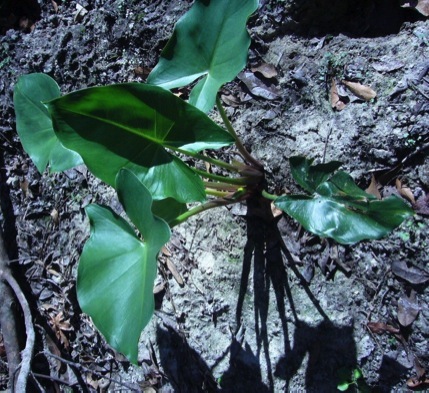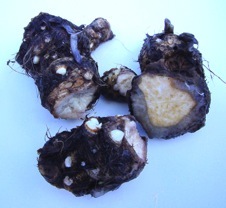
Prefers to grow in water or mud
Peltandra virginica: Starch Storer
You wouldn’t think there would be a connection between the United States’ Capital and a toxic bog plant, but there is. Much of the fine, white marble in Washington DC came from quarries in Tuckahoe, N.Y., north of Yonkers. Tuckahoe was named for one of the staple vegetables of the Indians in the area, now called Arrow Arum or Peltandra virginica (pel-TAN-dra vir-JIN-ee-ca.) It’s a plant with a rhizome laced with a toxin though the Indians knew how to get rid of. That Tuckahoe should be named after the Tuckahoe is not unusual in that Sag Harbor on Long Island was named after the Sagabon, another local root now called Apios americana, or Ground Nut or Hopniss. It, too, has to be cooked to be edible. See my article on it here.
The Arrow Arum, or Tuckahoe, likes still or slow moving waters: Ponds, swamps, marshes, and the banks of streams. It can grow in full sun to shade. Its native range is from east Texas to Florida north to the Great Lakes and southern Maine, though I did not see it there too often. It also is also established in California and Oregon. On the move, it has been located in spots in Minnesota, Kansas, Iowa, and southeastern Canada. In northern climes it goes dormant in winter; in the South, it stays green unless we get a frost or freeze.
Like other aroids the Tuckahoe is toxic and has raphides of calcium oxalate, microscopic needle-shaped crystals that cause severe swelling and a burning sensation as they puncture the membranes of the lips, mouth, throat, tongue, fingers et cetera. Swallowing too much of it can be a fatal mistake, though that is rare these days. The chemical can clog up your kidneys but that, too, rarely happens because of the one-minute after eating burning sensation. Like most aroids, this is a living-in-the-wild, long-term survival food. However, rid of the raphides the Tuckahoe is an excellent source of starch, very necessary for living off the land.
The raphides can be destroyed by very long cooking, heating or drying. The rhizome starch was dried and ground for making breads and soups. The spadix, fruit, and seeds were considered delicacies (after cooking them some nine hours or drying them and then cooking them for hours.) William Bartram reported that the Indians ate the long-boiled spadix and berries as a luxury. They have a hint of cocoa flavor. The growth dynamic is the plant produces berries then bends over and literally buries the blackish green seeds in the mud. (Sometimes the seeds can be yellowish.)
What most foraging books don’t tell you is the plant can be a chore to dig up. The starchy payoff is worth it but it is more a shovel forageable than a hand-dug one, though I have done that. If you are going to dig it up by hand I recommend elbow-length tough dishwashing gloves. The rhizome is covered in spaghetti like rootlets and thousands of small hair-like roots. It also likes to grow horizontally between one and two feet down in wet soil. It does not give up easily and often the mud it is in is… ah… aromatic.
Like the Jack-in-the-Pulpit the best use is to slice it up and dry it for a few months. It can also be roasted in an oven for a day or more, which is not cost effective. The Indians would collect them, bury them in the ground, build a huge fire over them and cook them for a day or more. Tuckahoe also respond to microwaving but it is hard to get the right timing between made safe to eat and turning to charcoal. However, microwaving them some shortens the drying time to edibility significantly. I nuke the slices one minute to 90 seconds and then let them sit until edible, which can be immediately to a few weeks.
Another technique I’ve used is my solar oven. I peel the roots and put them in whole. It takes about 10 hours of solar drying over two days to make them edible, though hard. I haven’t tried making them into chips and using a shorter amount of time.
The edibility test is the same for the Jack-in-the-Pulpit. To test them: Chew a quarter-inch square piece on one side of your mouth for a full minute then spit it out and wait ten minutes. And I mean chew for a minute and I mean wait ten minutes and I mean one side of your mouth (to limit the area that burns.) The effect can be quite delayed. If the calcium oxalate is still present it will make one side of your mouth burn, and your tongue and lips. That can last up to a half an hour or so. If no burn, try a bigger piece the same way. If no burn then, you’re ready to go. You can eat the dry chips as is, or grind them up as a flour. If you air dried them they can be used as a thickener. If you dried them at over 150F they can be used as a flour but not as a thickener because the starch will have already been cooked.
Peltandra is from the Greek words pelte for “small shield” referring to the leaves, and andros meaning “man” referring to shape of stamen standing in the spathe. Virginica, literally means of Virginia but botanically it means of North America It takes about 500 of its seeds to weigh a pound. Those seeds are a favorite food of rails, muskrats, wood ducks and black ducks. The Tuckahoe is also sometimes called “duck corn” after the seeds. Colonies provide cover for deer, beaver, muskrat, snakes, turtles, frogs, dragonflies, and fish.
Green Deane’s “Itemized” Plant Profile
IDENTIFICATION: Long, fleshy, arrowhead-shaped green leaves with pronounced veins on the undersides, the veins are parallel, radiating from the sides of the main veins. There also are a few spaced larger veins also parallel, two near the back of the leaf, see photo above, middle leaf. Leaves can be wavy along the edge and up to 18 inches long and nearly six inches wide. The plant can be up to a yard high. The rhizome is thick and grows horizontally about a foot down or more. A possible similar looking plant –when not in flower — is the Sagittaria but it has veins running from one point and the flower is three petaled white, whereas the Tuckahoe has a spike in a sheath that splits on one side. The spathe is four to seven inches long with many tiny yellow-green flowers on it, male part is on top, female part that produces the seeds on bottom. In northern areas don’t confuse the Tuckahoe with the water arum, Calla palustris which has heart-shaped leaves, a very white spathe and red berries (though it has roots that are edible after similar but more extensive rendering. (See article on Calla palustris elsewhere on site.)
TIME OF YEAR: Year round though best in early spring before seasonal growth or fall after seasonal growth.
ENVIRONMENT: Wet areas similar to cattails. Can grow in large colonies in shallow or slow-moving waterways, such as bogs, swamps and marshes. Will also grow in semi-dry well-flooded areas
METHOD OF PREPARATION: Method: Long term drying, long term roasting, microwaving and drying. Always tastes test twice before use. Peel the roots before you dry them, and you might want to consider wearing gloves when you peel them.



Is there any relationship to oxalic crystals and oxalic acids that would respond to lye, such as from wood ash?
I have not heard of that being done.
I am worried about you recommending Arums to be used….they can be quite dangerous …maybe a tag on these saying “ONLY USE IF YOU AN AN EXPERT” or something…I have been in several newspapers for my foraging know how and even I wouldn’t mess with the Arum. family…too risky for too little reward.
They have their own built-in caution system.
TY for every good thing you put forth. I have a few questions. I am in the area South and east of Austin, TX. I am not to far from the Lower Colorado River. My community is in a gravely to rocky sandy clay with a 6-12″ loamy silt layer on top. What WINTER wild edibles are there around to substitute/process for: SUGAR[ solid or liquid] , SALT, PEPPER, FLOUR[for bread or meal porage] and/or starch thickener, oil/fat[really curious about this one], coffee and /or tea [best tasting result], tissue paper, general herbal seasoning, and best tasting drink herb or the like. I like mint but haven’t noticed any. I am asking for the most prevalent and best tasting of each, not an exhaustive list, and all found presently in winter. TYIA for any help.
Have you visited the website Foraging Texas?
Also, more on topic to this page, what commonly found[to S.Cen.TX] wild plant substance can be used, say on a blow dart, to immobilize game, maybe even a wild hog? Once again, TYIA for any info and ty for your work.
Do you know if this all applies to the “invasive” italian arum, too? It’s all over the place in the northwest. We’re told that it’s poisonous to even touch the leaves.